Rocky Mountain Audio Fest 2014 • Coming Around Again
f ever you needed evidence of the crisis confronting high-end audio (and the myopic, blundering response of most of its protagonists), then you need look no further than this year’s Rocky Mountain Audio Fest. While exhibitors were busy complaining about the number and quality of the visitors -- and the familiarity of many of those who did visit -- online forums were awash with end-users saying that the reason they stayed away was because the show is "too busy"! Anybody would think that RMAF was on its last legs, whereas nothing could be further from the truth. Visitor numbers were up and those visitors who actually attended (rather than those who didn’t, so had time on their hands to kill in chat rooms) seemed well pleased with the event. Running cartridge setup seminars across the three days, we didn’t have a single spare seat, with many of the sessions crowded with those prepared to stand through the hour-long presentation -- and continuing in the corridor outside long after they should have finished. Why the disparity in views and differing experiences? Perhaps the answer can be found in the near riot that occurred each time AudioQuest tried to close the door on their Computer Audio Optimized sessions -- that and the fact that CanJam had overflowed their ballroom space and was packed all weekend. Admittedly, the rise of file-replay sources (as well as the understanding that they’re not quite as simple as some of us thought they were) and the booming market for all things related to portable listening and headphones are hardly news. But what was so striking about the RMAF experience was just how deep the division between the CanJam crowd and the traditional two-channel-separates brigade has become -- and how incapable the latter seem to be when it comes to crossing that divide. If the number of visitors was up yet the lines for elevators were shorter, it was because many visitors came for CanJam, visited CanJam and then departed without troubling the upper floors. That and the fact that the public has finally cottoned to the fact that if you start at the top of the tower, then even in Denver’s rarified air, walking down a floor at a time is quicker and easier than waiting for an elevator that will probably already be full. Apart from a few notable exceptions (Simaudio demonstrating the headphone amp they launched in Munich and Crystal Cable announcing a co-branding initiative with Astell & Kern that sees them providing dedicated cable sets to connect the portable players to both headphones and high-end systems) there was precious little initiative on the part of the established high-end manufacturers when it came to building bridges with the buoyant headphone market. They all talk about building headphone amps, but few if any of them seem to actually be talking to their potential customers. This isn’t just a case of Mohammed and the mountain; it's more a question of who is the mountain and who is Mohammed. Of course, one advantage enjoyed by those demonstrating headphones is their self-contained acoustic environment. No struggles with challenging rooms and the hotel décor. Upstairs in the various bedrooms, there were those who threw the proverbial acoustic kitchen sink at the problem. Then there were those who opted to work with what they had, adopting the established route of smaller speakers and lower levels to overcome the environmental limitations. Guess which approach worked best?
Alternatively, you can always use super-advanced digital feed-forward processing power to provide both system and room correction. Tucked away in a small room on the Atrium block’s fifth floor, Goldmund set out to show the rest of the industry the error of their ways, with a setup of unmistakable but remarkably simple appearance, built around a pair of their new Prologos Plus loudspeakers ($40,000/pair). The blocky cabinets were supported in their characteristic "deck-chair" stands, the angled cradles augmented by the ground spike linking the boxes to the floor. Sat between them were a pair of typically svelte components, the compact and elegantly styled Eidos 17 CD player and Mimesis 11 "digital hub" ($10,000 each). But there was much more (and less) to this system than initial appearances suggest. First -- and most obvious -- was the lack of interconnects and speaker cables. Like the Avantgarde Zero speaker system, the Goldmund setup communicates wirelessly between source and speakers, using proprietary 2.4GHz coding. The speakers themselves are three-way, active designs, with digital-domain crossovers, two 175-watt amplifiers driving the tweeter and 7" midrange, with 250 watts deployed for the 9" bass unit. As if that weren’t enough, these speakers incorporate the fruits of Goldmund’s Project Leonardo digital feed-forward error-correction system -- technology that allows the designers to not only compensate for time, phase and amplitude errors in the speaker system and drivers themselves, but also to "map" specific listening environments and afford sophisticated room correction. It’s a capability that the company were worryingly willing to demonstrate -- worrying because of their established dedication to dynamic range and bandwidth as well as the sheer levels they could drive the system to without overloading the room. Playing more familiar material at more modest levels, the system was astonishingly transparent, immediate and detailed -- all the hallmarks of classic Goldmund performance -- with amazing clarity, separation and intelligibility, demonstrating just what happens when you take the room out of the equation. The lean balance and lack of excess warmth might not be to every listener’s taste, but if resolution is your bag, then this is a system that shows the likes of darTZeel and Soulution a clean (in every sense of the word) pair of heels.
Adopting an altogether more conventional approach, the irrepressible Angie Lisi of Audio Pathways (and long-established Toronto dealer Angie’s Audio Corner) was doing an excellent job of representing the Bergmann turntables from Denmark, stretching her wings below the 49th Parallel for the first time. Both the Sindre (left, $28,000) and Magne ($16,500) ‘tables employ the same linear-tracking, air-bearing tonearm and single-axis air-bearing platter (spinning on a steel shaft but vertically supported on an air cushion). A dual-mono Sutherland Phono-Block ($10,000) fed Bel Canto’s high-end Black electronics (ASC1 streamer/controller and MPS1 mono amps -- $55,000 the set), driving a pair of Focal’s Diablo Utopia stand-mounts. The system sat atop Harmonic Resolution Systems’ elegant new RXR rack with its attractive blond wood frame and was wired together with Crystal Cable Ultra cables. But perhaps the most unusual and quietly impressive component in this setup was the two black boxes on either side of the rack, the air pump/reservoir units feeding the ‘tables, demonstrating just how quiet Bergmann have gotten this previously problematic part of the air-bearing package. The smaller Magne was sporting an Ortofon Cadenza Red cartridge ($1200), but it was the Sindre that I heard, fitted with the almost ubiquitous (but no less wonderful for all that) $6995 Lyra Etna. The sound was wide open, grain-free, fluid and unforced, exhibiting all the natural rhythmic and spatial integrity that goes with a good passive, linear-tracking tonearm and low-noise ‘table. Rickie Lee Jones’ breathy vocals were tonally natural and super expressive, while even her tendency to over-weight the bottom end -- and the Diablo’s willingness to oblige -- didn’t disturb the engaging, enjoyable quality of this system. Despite being a late entrant the success on show here demonstrates just what a really experienced dealer can achieve, even under difficult conditions and at short notice. But the rooms mentioned so far were the exception to the rule, with too many exhibitors playing too loud, and in some cases seemingly preferring the sound of their own voices to the sound of their systems. Compiling a list of memorable rooms, it was the old guard who once again stepped to the fore, the sense of déjà vu reinforced by the fact that many of these systems could be mistaken for the same company’s setups last year -- a definite case of evolution rather than revolution. In Jeff Rowland’s case that has more to do with conceptual continuity and having one of the strongest visual identities in the business than running a near-identical system. This year, the Capri preamp with internal DAC ($4400) was paired with two of the diminutive Model 125 stereo amps ($2950 each), bridged for mono and driving Joseph Audio’s deservedly well-regarded Pulsar compact stand-mounts ($7700/pair) via Nordost Valhalla 2 cables. Source was a Bryston BDP-2 ($2995) that was either used as a disc-storage device or to replay music files from dongle and the components sat on yet another HRS stand. As well as the sense of familiarity created by the compact speakers/compact electronics combination, the demo material was another link to last year’s show, this time pre-release "rushes" of a recent Beethoven 9th performance by the Colorado Symphony. Scheduled for release next year, having family on the Symphony’s technical staff gives Rowland access to official "sneak previews." exploited to excellent effect. Despite the diminutive amplifiers and compact loudspeakers, they were able to project a sound with real presence and scale, a palpable sense of performance and impressive dynamic range. This system enjoyed the same communicative connection and inside-out quality that made the Continuum integrated such a musically appealing product, with a real feeling of the orchestral energy and performance starting "over there" and passing over you. If the Goldmund system offered a window onto the future of digital signal processing and transfer, Rowland were giving a glimpse of just how file replay can offer a lifeline to struggling orchestras and an inside line to classical music consuming audiophiles. The musical qualities on display here suggest that the own-label releases that are helping to swell orchestral coffers around the world are only the tip of the iceberg, with huge potential in the areas of live streaming and concert downloads. If the results get anywhere close to the excerpts that Rowland were using, then the future for orchestras and orchestral music is definitely looking brighter.
Now come a series of rooms in which you could be forgiven for mistaking the system for the same one played last year -- at least at first glance. I guess the logic is, don’t mess with success -- a sentiment that was certainly born out by the results. Mustering behind the lead of Fort Collins dealer The Audio Alternative, Audio Research and Vandersteen put on their usual excellent show, this time downscaling the electronics to a Reference 5 SE line stage ($13,000), Reference Phone 2 SE phono stage and Reference CD9 disc player ($13,000), paired with the familiar Vandersteen Model 7 speakers ($52,000/pair). Big changes from last year were the use of the new Brinkmann Spyder modular turntable (in place of an AMG, $14,000) and Vandersteen’s M7-HPA amplifiers ($52,000/pair) instead of the Audio Research Reference 250s. Cartridges mounted on the Brinkmann 10.5 tonearms ($6300) were a Lyra Atlas ($6995) and Kleos mono ($2995), while cabling was all AudioQuest (mainly Wild Blue Yonder signal cables and NRG-1000 power cords) and racks were, naturally, from HRS. Despite the apparent similarities, this was a very different-sounding system from last year. Switching the main cartridge from the Etna to the Atlas is hardly going to go unnoticed, but taking a step back on the preamplification and inserting the Vandersteen power amps made for a fascinating contrast. The impressive sense of acoustic space and definition was gone, replaced by a more immediate, quicker and far more dynamically impressive presentation. Separation was explicit and the soundstage incredibly broad. Playing Simon and Garfunkle tracks, there was a beautiful sense of distinction and texture in the harmonies, with a grip, attack and authority to the guitars, backing and percussion that you wouldn’t expect from this material. On jazz, rhythms were notably fluid and expressive, with suitably explosive horn interjections. There will definitely be those who prefer the more holistic and spatial coherent presentation from last year -- just as there will be those who warm to the impressive dynamics, clarity and separation of this system. The bottom line is that it’s nice to hear a system that plays to its strengths -- and a setup that’s not afraid to exploit them. Just as there are those who prefer the Atlas to the Etna -- and vice versa -- this system clearly shows that the Audio Research/Vandersteen pairing isn’t just a one-trick pony. If spatial integrity and overall coherence are your things, then the Reference 250s and the Etna make a powerful combination. But once you’ve decided to pair the ultra resolution and dynamics of the Atlas with the Vandersteen amps, you’d better go for broke. That’s exactly what The Audio Alternative system did, to impressively dramatic effect.
Yet another blast from the past (well, last year anyway) was the Musical Surroundings system, the best of the large rooms on the mezzanine level. This again paired a Clearaudio front-end with Aesthetix electronics, Focal speakers and a complete loom of Nordost Valhalla 2 cables. The turntable in question was again the Master Innovation, although this time it was the black-lacquered Wood model ($29,400) with matching Olympus stand ($13,400), only this year it was all dressed up with three tonearms: The Graham Phantom Elite 10" ($12,500) carried the obligatory Clearaudio Goldfinger Statement ($15,000); an AMG 12J2 tonearm ($4500) was paired with an AMG Teatro cartridge ($2750); but the most interesting combination was undoubtedly the Tri-Planar U12 tonearm ($9800) mated to the new DS Audio DS-W1 pickup, a cartridge that uses an optical reader (and dedicated electronics) rather than a conventional generator (around $10,000 for cartridge and gain stage). These fed (at least the conventional cartridges did) an Aesthetix Rhea Signature phono stage ($7000) and the new one-box Metis line stage ($20,000), which features a clever internal, mechanically and electrically isolated power supply. This also features the most ostentatious blue knobs you are likely to see -- quite a change from the subtle, conservative styling of the other Aesthetix products. The company’s final contribution was a pair of the mighty Atlas Signature monoblocks (a serious sonic and musical bargain at $16,000 the pair). The system’s equipment was all supported by the interesting Critical Mass Soto Voce racks ($4500 each), one of the few serious alternatives to the various, but all-conquering, HRS designs. So far so good -- and distinctly reminiscent of last year’s excellent system. The big change occurred with the speakers, the Scala Utopia V2 being replaced by the Stella Utopia EM ($97,000/pair), from two steps up the Focal flagship line. Roughly twice the size and three times the price, the Stella brings more than extra volume to the party. Its 13" bass unit is an EM design (employing an electromagnet and similar to the unit used in the Grande), giving considerable benefits of tuning the driver in terms of both output and in-room response. The absence of the upper-bass driver used in the Grande also means that the EM technology works over a wider bandwidth, reaching up into the critical midbass area, which impacts so fundamentally on our sense of power and musical impact. No surprise then to discover the effervescent Garth Leerer impressing and scaring visitors in equal part with the venerable Reference Recordings Symphony Fantastique. But as impressive as the Atlas/Scala combination was in terms of bandwidth, dynamic range and apparently bottomless power (something of an Atlas party trick to be fair), what got me really excited about the performance of this system was the blinding speed and linearity of the DS Audio pickup. The system allowed direct comparisons between the three 'arm and cartridge combinations, and the novel operational approach employed by the DS-W1 left the Goldfinger Statement sounding sluggish and clumsy in comparison -- something that it genuinely isn’t. The new cartridge’s speed of response, attack and rise time made it sound almost mass-less, while giving the music a sense of dynamic authority and rhythmic purpose that was very impressive indeed. There’s no getting away from the price tag that appends to the equipment here, but it was having a seriously good go at justifying that elevated cost. The transparency and enthusiastic dynamic response of the speakers, the sheer power of the amps and the presence and purpose of the preamplification all worked together to showcase the stunning, quick, uncluttered and lucid signal coming off of the record player. Meanwhile the coherent approach to cabling and support helped hold the whole thing together, creating a huge soundstage of tremendous stability and integrity. But more than that, this was a system with power on tap and delicacy too, one that allowed the performance to breathe and emote, rather than hurling it into the room. Once again, Musical Surroundings (with two systems using Focal Grandes on the same floor) were able to produce far more impressive musical results from the more affordable speakers and system. And while we’re talking about price, let’s not forget that the estimated $10,000 ticket on the DS Audio cartridge includes the necessary phono stage -- making this one very serious high-end analog contender indeed. This was the most exciting single product I heard at the show and I suspect that Garth will be fighting off reviewers with one hand while trying to secure supplies with the other. Like they say -- order early to avoid disappointment. Which brings me to my two favorite rooms at the show -- rooms I visited more than once for brief musical interludes amongst the chaos of trying to run seminars and write a show report. They never failed to refresh or satisfy, although one only made the top step of the podium late on Sunday.
The VTL/Wilson Audio room was again one of the show’s highlights -- as well as one of its more interesting touchstones, at least on a personal level. For the last five or so years, VTL has occupied the same room, mixing and matching their components with a speaker manufacturer, generally but not always Wilson Audio. For most of the last five or so years they’ve relied on Spiral Groove and dCS front-ends, together with a mixture of Nordost power and Transparent Audio signal cabling. And for the last five or so years I’ve turned up in their room in what has become something of a ritual, to hear Bea Lam play the DGG pressing of the Giulini/Bendetti Michelangeli/VSO performance of Beethoven’s 1st Piano Concerto. By now it has become both a tradition and an invaluable benchmark, showing year on year changes in both their system and acting as an overall measure for the other systems I hear.
This year was no different. Indeed, if any system looked unchanged from last year, then this was it. The setup consisted of a Spiral Groove SG 1.1 turntable and Centroid 'arm ($31,000) carrying a Lyra Etna cartridge ($6995). Electronics were VTL’s TP-6.5 Signature phono stage ($12,000), TL-7.5 Series III line stage ($25,000) and what looked just like the Siegfried II mono amps from last year. Speakers this time around were Wilson Sasha 2s ($30,900/pair), although these too could have been mistaken at a quick glance for last year’s Alexias. But look a little closer and the differences started to become apparent. The Sasha 2s were backed up by a pair of WATCH Dog subs ($13,800 each, including controllers), tucked unobtrusively into the rear corners and those amps weren’t Siegfried IIs -- they were S-400 IIs ($33,500 each), vertically biamping the speaker/sub pairings. Cables were still Nordost Odin and Valhalla for the power, Transparent Opus MM2 and Reference for signal, with digital duties performed by the dCS Vivaldi transport and DAC ($75,000/pair) as well as Peter McGrath’s portable hard drive from which he played his own recordings. Once again, HRS provided the racks. I’ll admit to confusion regarding the absence of an external clock for the Vivaldi, being only too well aware of what even the basic uClock brings to that party, but as I was mainly interested in vinyl we’ll let that pass. Less understandable was the decision to run Transparent’s Opus MM2 speaker cables to the Sasha 2s but "only" Reference XL to the subs. In a system with this combined price tag and this level of performance, that really is (just like excluding the clock) a false economy. It also shows the cracks that can appear between exhibitors who contribute separately to a single room. Let’s be honest -- if you’ve got the front to ask Vivaldi and Opus MM2 prices for your products, you should be taking every opportunity to show just why they’re worth the money -- not scrimping to try and make them look more affordable. But let’s worry about what the system actually sounded like -- which was, in a word, magnificent. At least it was on Sunday. Earlier in the show it lacked the clarity, sense of musical purpose and sheer authority that it delivered so effortlessly on the final day. Why? A small but significant change in the setup transformed things, underlining just how critical each and every aspect of a big and complex system like this is to its final success. But once singing, this is by some distance the best sound I’ve heard VTL make in that room, with Wilsons or any other speakers. The combination of the Sasha 2s and WATCH Dogs delivered a remarkable sense of scale, presence, air, delicacy and acoustic space, while the biamped S-400 IIs delivered all the power and dynamic authority and control you could demand. Bass was lucid, agile and pitch precise, but it was the air and space at the other end of the spectrum that really made the difference. The Stella/Atlas combination was impressive when it came to sheer scale, but was bettered by the VTLs and Wilsons, not in terms of quantity, where the two systems were pretty much on a par, but as regards the naturalness of the playing, the overall coherence of the stage and the range of musical muscle and expression achieved. Michelangeli’s fluid playing and astonishing touch have never been so convincing, his attack so clean yet devoid of edge, Giulini’s masterful control of the Vienna Symphony and his perfect balance with the soloist never so apparent. This was a system and a performance in which you could easily lose yourself, transported to the live event, dazzled by the virtuosity. When I forced myself to rise from the hot seat, Luke Manley was concerned that I might not have heard enough. Believe me, it only took a few seconds to appreciate just how good this system was. After that, it was all pure pleasure. Bringing such a complex, powerful and wide-bandwidth system to a show is always a high-risk strategy. Knowing the room that you’ll be working in is a huge help, but even so,VTL and Wilson deserve considerable credit for having the courage to try this setup and the skills to pull it off to such spectacular effect. As good as it was sounding on Friday and Saturday, many exhibitors would have been tempted to leave well alone. But that last little tweak (and let me reassure you that it was purely organizational and had nothing to do with dead chickens) raised the level from very good to truly great, bringing the necessary articulation and musical clarity to the performance to elevate the artistry, revealing the sublime. The Giulini/Michelangeli disc is a brilliant musical document, but it’s demanding too, and any system playing it must meet those demands. This one did -- and did it under show conditions -- which is impressive indeed. I listened to a range of other material too, and vocals, solo or choral, were particularly natural and expressive, but this is the record and the performance that sticks in my mind. The Sasha 2/WATCH Dog setup might not look like the value option on paper, especially when you factor in the cost of the additional amplification, but you can’t argue with the results. Switch the subs off and just listen to what you lose. Special mention must be made of the superb integration of the subs and the main speakers, but as past experience has shown, a huge part of that comes from the WATCH Dog’s peculiar topology, which allows you to employ identical amps across the entire bandwidth. It’s a strategy that delivers a massive dividend in musical performance, one that was exploited to the full here.
Follow that, you might well be thinking, but that’s exactly what the BorderPatrol/Volti Audio room managed to do. Once again, this was a serious case of déjà vu, with electronics and speakers identical to the system I enjoyed so much last year. So what elevated the system to the top step of the podium this time round? I know that finish shouldn’t come into it, but the new Rosewood veneer on the Volti Vittora speakers definitely raised the aesthetic game as far as this $25,000, five-cabinet horn system is concerned (that’s two twin cabinet three-way speakers and an additional subwoofer). These speakers were always a massive bargain, partly because of the company’s direct-to-customer sales model. Now they’re a bigger bargain still. Of course, horns are a double-edged sword, one that will cut you if you handle it carelessly. Ill-considered or inadequate amplification need not apply; don’t get fooled by the efficiency of the speakers, low output power might be acceptable, but wimpy power supplies are definitely going to be exposed. Which makes the choice of the BorderPatrol S20 EXD amplifier with a pair of the massive EXS power supplies ($25,750 -- the parallel single-ended version of the push-pull 300B P20 that I recently reviewed) an excellent albeit not inexpensive choice. But combine that with the Border Patrol EXT1 control unit ($12,250 with a single external supply) and USB DAC ($975) and you wind up with an electronics package that is considerably cheaper than most of the alternatives on show -- as well as quite a bit heavier. Whichever way you cut it, pound for pound or pound per lb., this system looks like excellent value, a quality that extended to the ancillaries. Source was a modified Tent Labs kit CD transport, while equipment supports were homemade, heavyweight plywood tables. Which brings us to the cables and the one big difference from last year. The entire loom, from wall socket to speaker terminals was supplied by Triode Wire Labs, the most expensive pair of cables being the speaker wires at a mighty $599 the pair. With power cords starting at $349 each and interconnects costing the same, these are almost indecently affordable cables, at least in audiophile terms. Yet knowing just how critical coherent cabling across a system can be, I’m not surprised to hear Greg Roberts of Volti crediting them with the lift in performance. Playing the finale of the live acoustic Jackson Browne disc Love is Strange, the musical intensity and energy, the chemistry and rapport between the musicians was almost palpably apparent. The flashing fingers of guitarists and palms on percussion, the intimacy of the vocals and the unmistakable impact of David Lindley on proceedings were all captured and projected into the room, throbbing with the heat and atmosphere of that Barcelona night. As my neighbor said, as proceedings drew to a riotously enthusiastic close, "Wow, they were really on one," and with the BorderPatrol/Volti setup there was no missing that fact. Live discs are always a good test of a system’s dynamic integrity and manners. Playing Nanci Griffith’s One Fair Summer Evening is a case in point. But when her lilting vocals pushed an edge into the mics, the speakers refused to be drawn. Yes, her surprisingly powerful voice is overloading the onstage microphone, but this system just made you aware of that, rather than adding to the problem. Instead it added to that frisson of live performance, the sense of being there and direct communication. This was great music, powerfully yet sensitively portrayed by a really well-sorted setup that, whilst far from inexpensive, can be purchased in its entirety for less than the price of many of the speakers and even some of the turntables being used in other rooms. When it comes to audio, there’s no substitute for experience coupled to care and attention to detail. BorderPatrol and Volti have been working together for a few years now, and it shows. This is one system you can throw anything at and still enjoy the results. Perhaps the acid test is large-scale orchestral music, and although I didn’t play any this year, in years past the system has excelled, almost as if the more you ask of it, the more it gives. Yet more important even than that is that it makes listening fun. If you don’t enjoy music on this setup then you need to get medical help. You could well be dead from the neck up.
Duck for cover Not awarded on the basis of sound this year, but the
making of naïve and inflammatory comments. Congratulations to the self-styled industry
savior who was heard to say, "This show wouldn’t exist if it wasn’t for
Robert Harley!" Look out! Here comes another quart of Kool-Aid. |

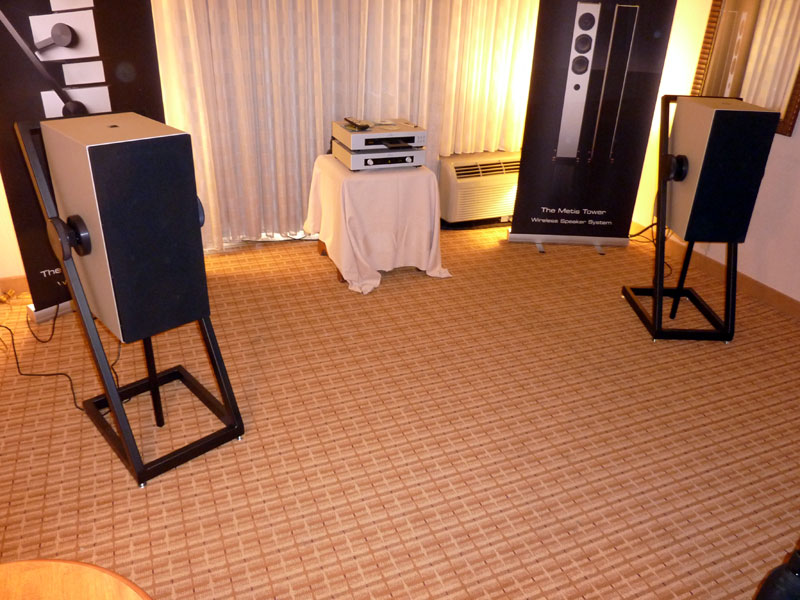
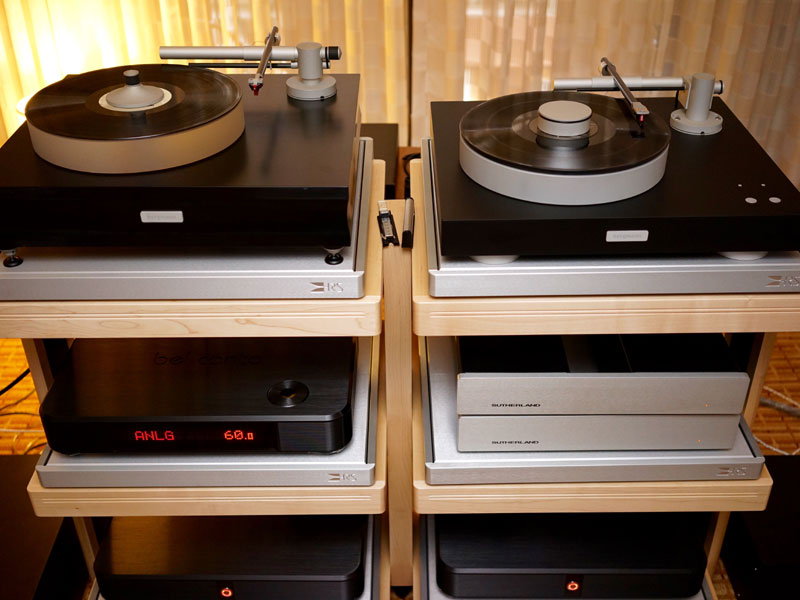
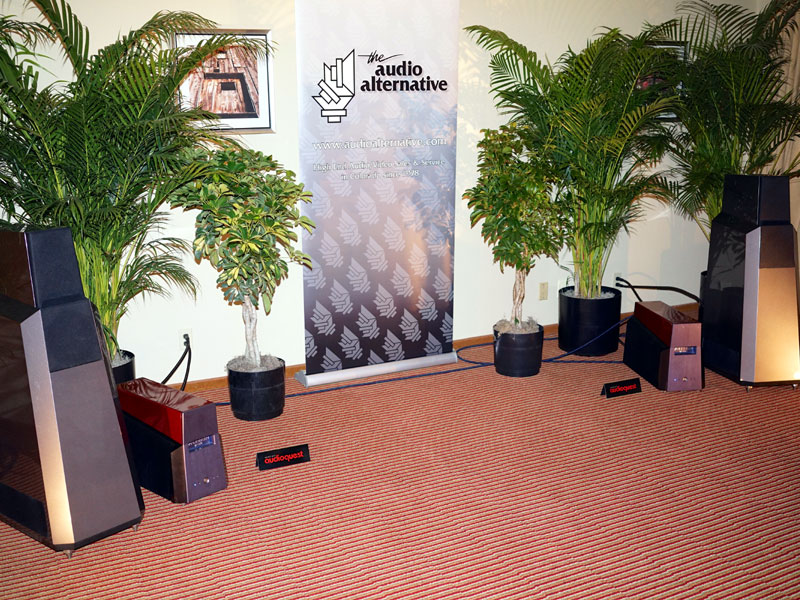
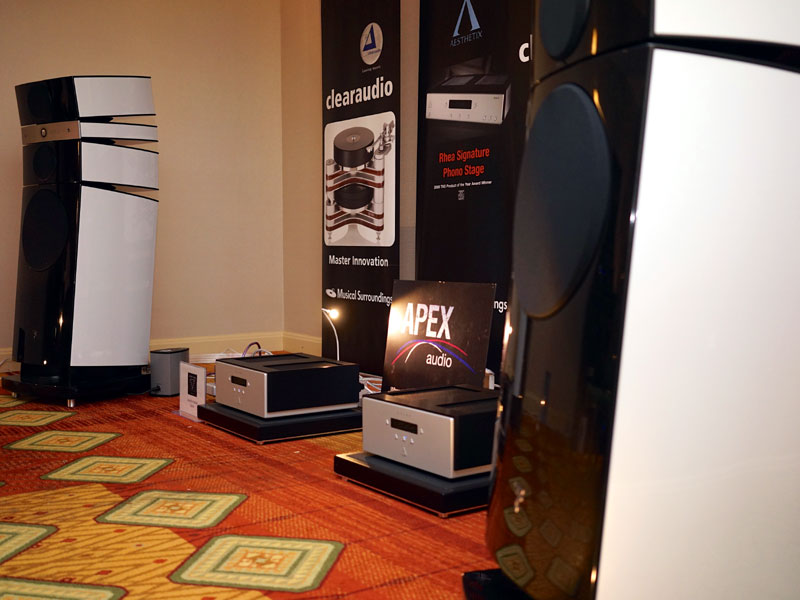
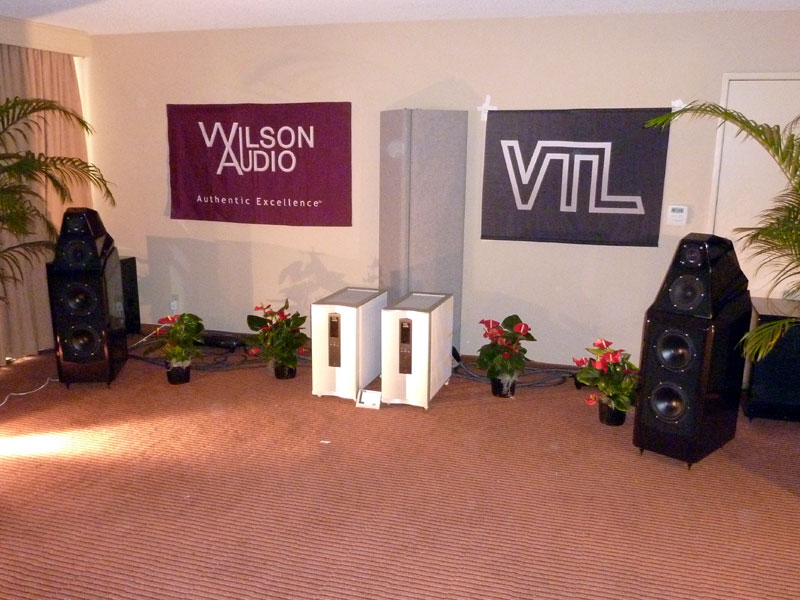
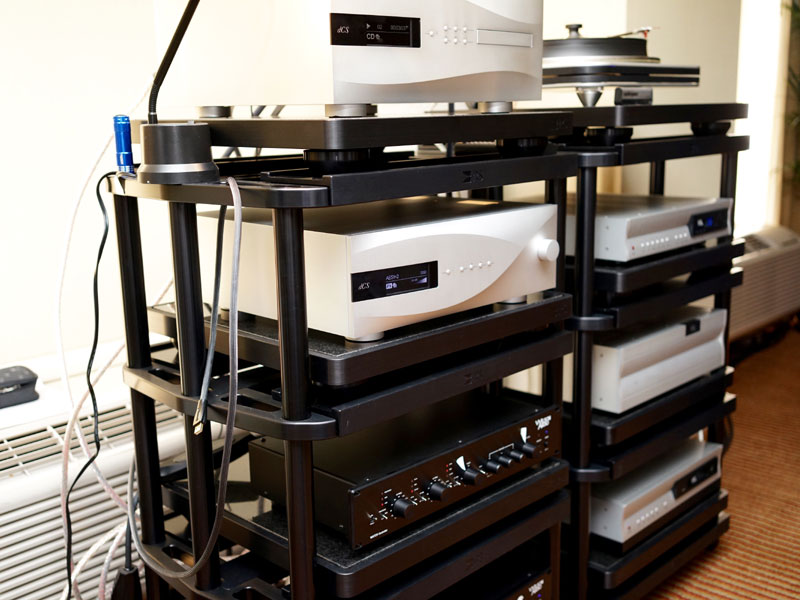
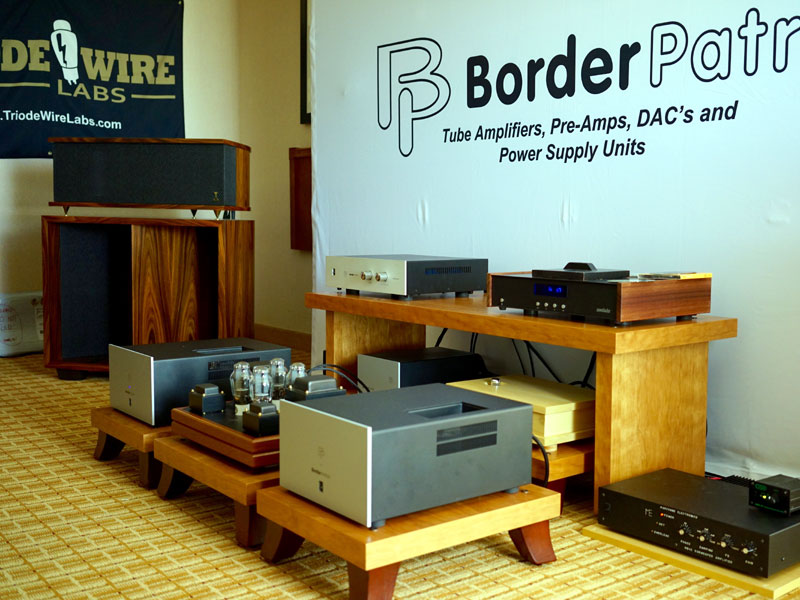
 So by and large the rooms
that impressed last year impressed again this year. The systems have evolved rather than
changed wholesale, and I suspect that that has played no small part in their ongoing
success. The VTL room was majestic, while the BorderPatrol/Volti system knew just how to
get down and get dirty. The most impressive single product was a cartridge, and the Lyra
Etna still sounds oh so sweet. Plus ça change, as they say in France. Another
year, another show but definitely déjà vu.
So by and large the rooms
that impressed last year impressed again this year. The systems have evolved rather than
changed wholesale, and I suspect that that has played no small part in their ongoing
success. The VTL room was majestic, while the BorderPatrol/Volti system knew just how to
get down and get dirty. The most impressive single product was a cartridge, and the Lyra
Etna still sounds oh so sweet. Plus ça change, as they say in France. Another
year, another show but definitely déjà vu.